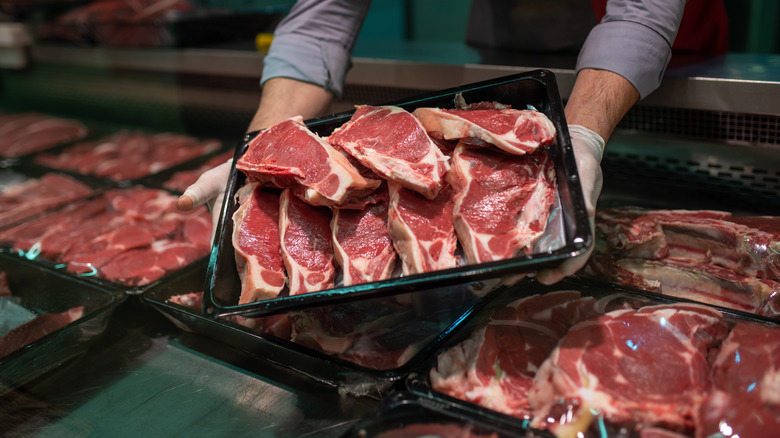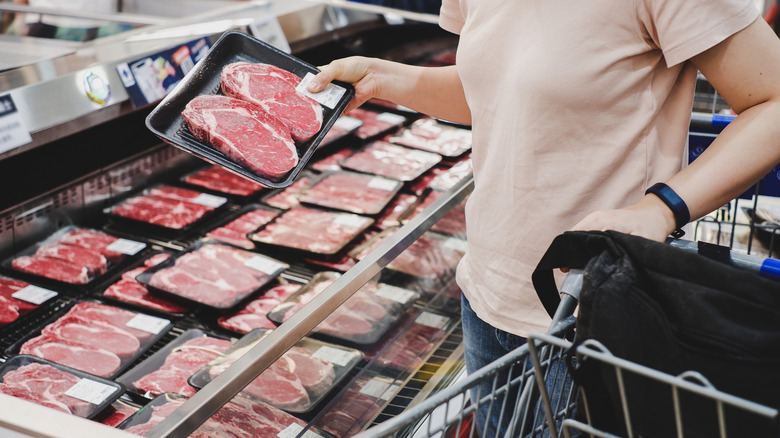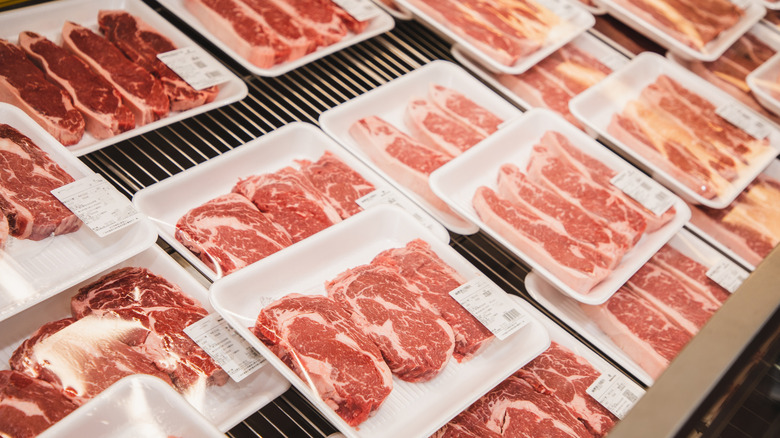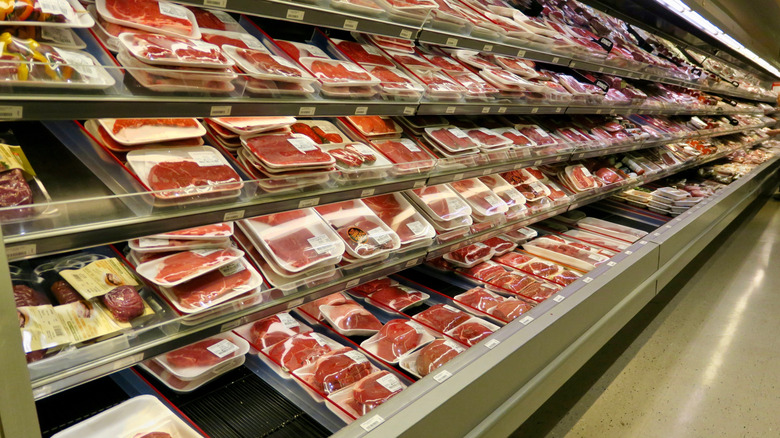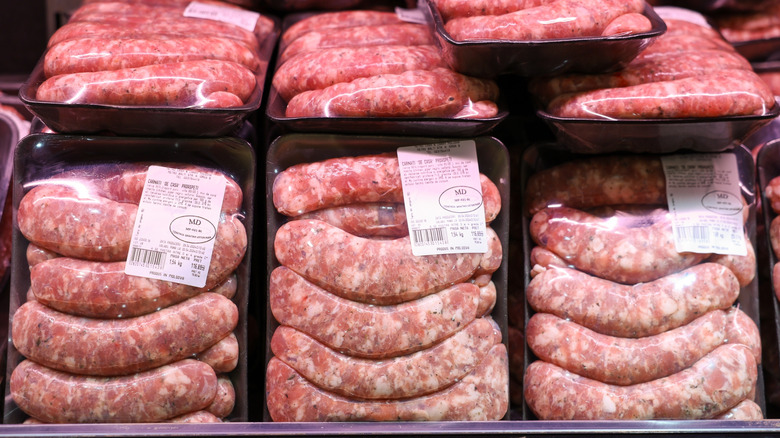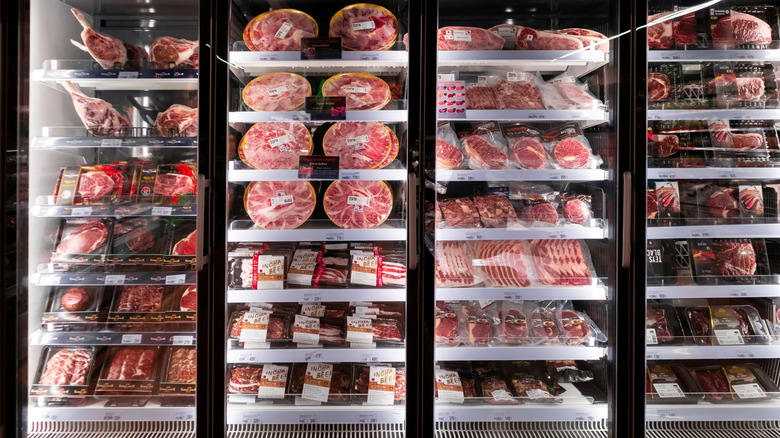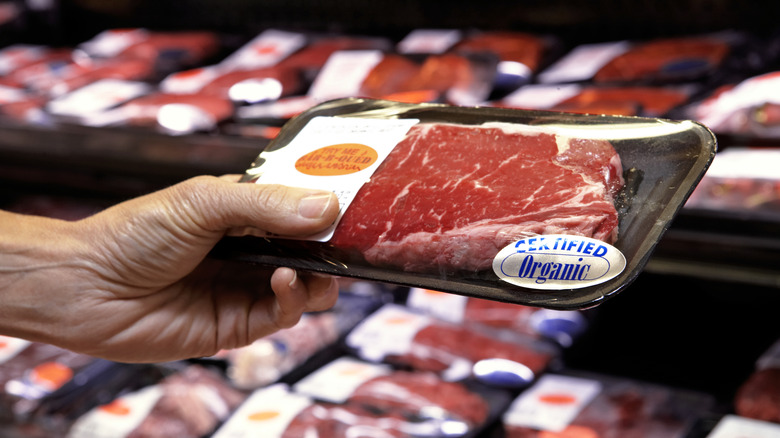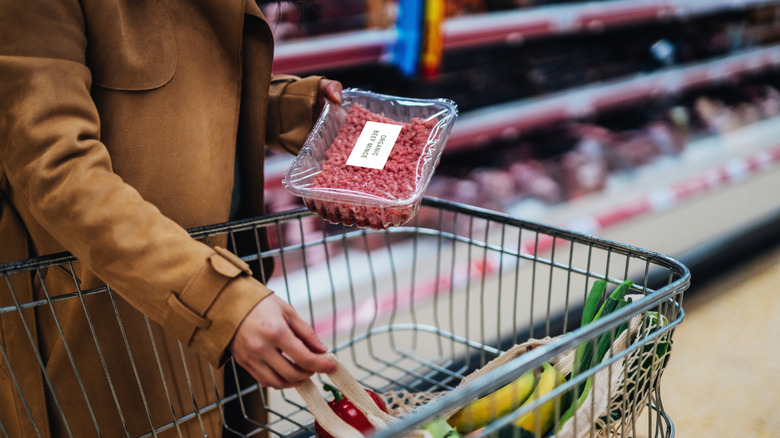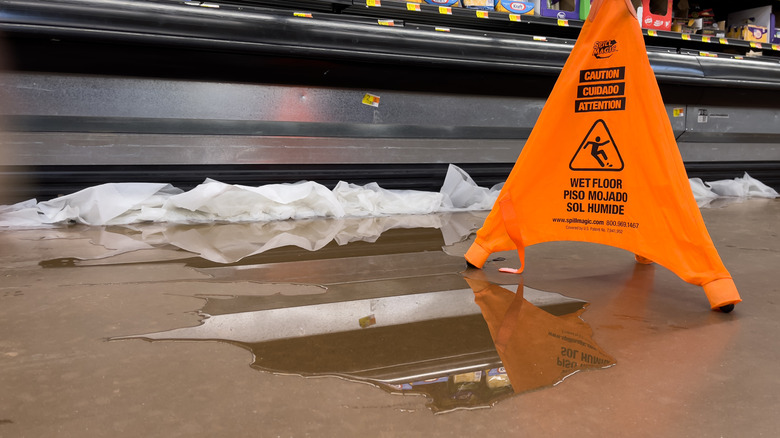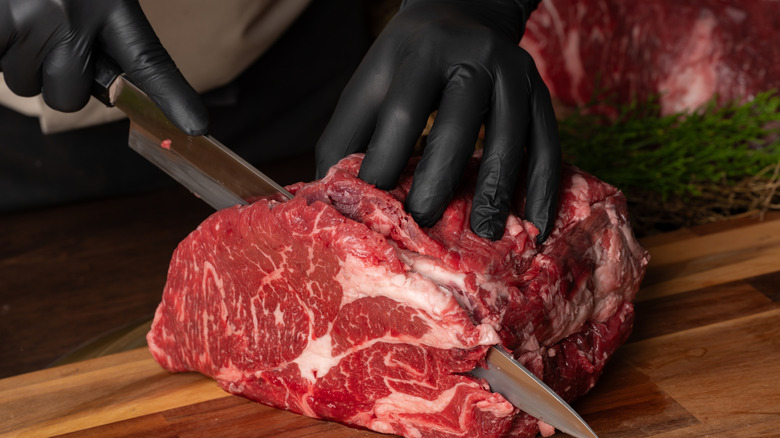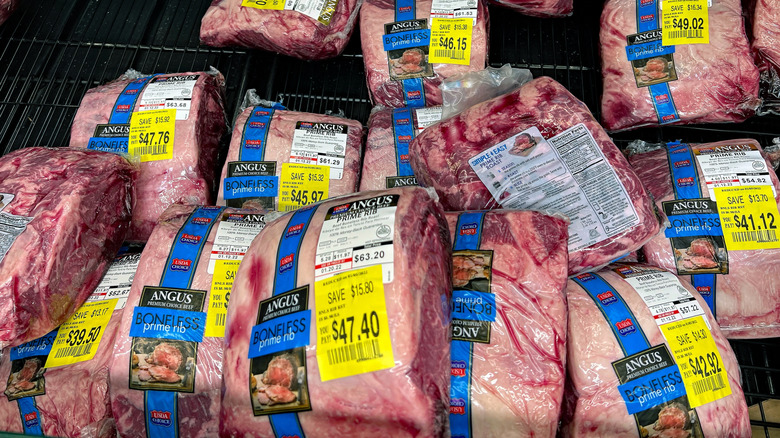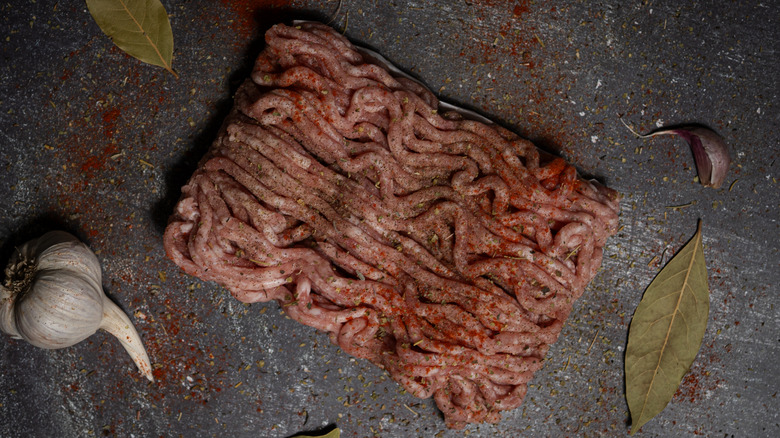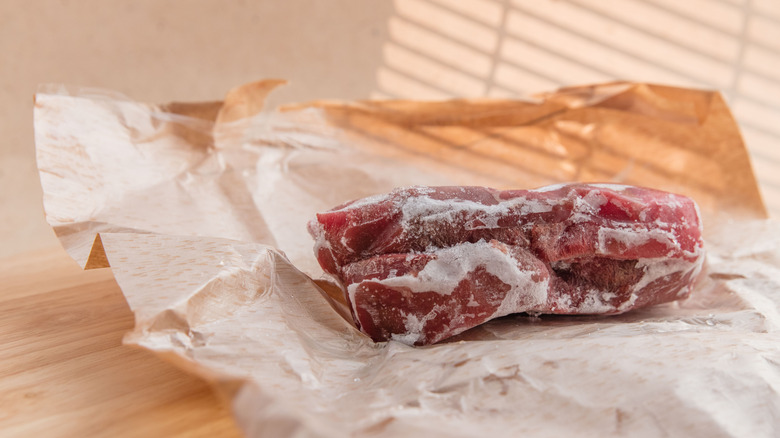12 Red Flags You Should Never Ignore In The Grocery Store Meat Department
The days of buying meat from a butcher are kinda long gone, folks. That's not to say that butchers are out of fashion or have disappeared (we definitely love getting that extra bit of expertise and quality when we get our meat) but nowadays, you're far more likely to buy your meat at the grocery store. In 2022, people across the U.S. spent $86.6 billion on grocery store meat, according to Statista, marking an increase of over $20 billion in just five years. One of the main reasons people go to grocery store meat departments is for their reliability — and yet, these departments can be surprisingly risky, and full of warning signs that should put you on guard about the quality of their produce.
These red flags can be pretty tricky to spot, too. Red flags in grocery store meat departments aren't always related to the meat itself, and can be related to the hygiene standards of the surroundings. There are also certain sensory clues that you can pick up on in these departments that give things away. That's all before you get to the meat itself. How it looks and the kind of info that's on the packaging can be big giveaways of its quality.
There are pools of liquid in the packaging
There's nothing worse than dry, fibrous meat — but if the packaged meat in your grocery store looks a little too wet, that's definitely not a good thing either. There's one big telltale sign that grocery store meat isn't being stored properly, and that's that it has pools of liquid at the bottom of its packaging. This liquid is known as "purge," and while it might have a pinkish or red tone, it's not blood. Instead, it's water mixed with a protein called myoglobin, which tints the liquid its reddish color.
This purge leaks out of meat as its proteins relax and break down, which happens as meat gets older. It can also happen faster if your meat has gone through drastic changes in temperature. However you look at it, a lot of liquid in the package at your grocery store may either mean that it's been kept at the wrong temperature, or that the meat you're looking at is about to go bad. Normally, there should only be a tiny amount of purge at the bottom of a package, if there's any at all. It's generally soaked up by an absorbent pad underneath your meat, and the presence of pooling liquid indicates that this pad has become overly saturated.
The packages of meat look bloated
Ever picked up a pack of one of the many different types of grocery store meats and noticed that it's a little puffier than usual? You should run for the hills, friend. Bloated packages of meat are a telltale sign that the grocery store you're in is failing to manage its stock properly, or that it's got meat from a poor source. When meat is exposed to oxygen, it can cause bacterial growth — and these bacteria will then release carbon dioxide within the package, creating bulging. As Jason Tetro, microbiologist and author of "The Germ Code," explains to Simply Recipes, "much like humans, when bacteria eat, they create waste in the form of chemicals and gases." He continues, "in an enclosed space with no holes, that gas will accumulate and eventually lead to swelling."
As bacteria grows over time, bloating could therefore be a sign that the meat has been sitting around for a while. It could also flag that the manufacturer wasn't producing the meat in super-sanitary conditions. It's worth pointing out that swollen packaging may sometimes be by design, so check for uniformity amongst all the other packs. The meat inside your package may also not be harmful to eat — but may not be very tasty either.
The department looks noticeably dirty or messy
Have you ever just felt like something's a little off in your supermarket? Maybe things aren't as ordered as they could be, or it looks like it needs a clean? Well, that might be okay in certain parts of the store, but in the meat department it's a huge red flag. Hygiene standards are hugely important when it comes to supermarkets, and if you get the sense that things haven't been cleaned in a while or restocking is haphazard, this could be an indicator that management isn't investing enough in the training of their staff. If they're not doing that, how can you trust them to handle meat correctly?
This is why it's also useful to look really closely at the shelves and fridges in the meat department. If you spot any spillages that haven't been cleaned up, or wet or sticky patches, this could indicate that meat had leaked here previously, creating a hotbed of bacteria. This doesn't just go for the packaged meat section, either. Take a good look at how the meat counter or in-store butcher's section manages its hygiene. Things are arguably even riskier here, as raw meat is being handled regularly.
There are torn or leaking packages of meat
When it comes to packaged meat, a little cosmetic wear and tear is generally fine. If the box it comes in is a tiny bit scuffed, but there's no actual damage to the packaging, then it could still be good to go (and you might be able to get a nifty little discount on it). If, however, the packaging is torn or leaking, then this is a much bigger problem. When meat is exposed to air, it can begin to grow bacteria and spoil, creating a potentially hazardous situation.
What's more, torn or leaking packages can drip meat juices onto other ones, making an even wider unsanitary area. You don't know exactly where those meat juices have seeped into, and any package you pick up could be unsafe. More generally, torn or leaking packages that are being proudly displayed in a grocery store meat department really do just flag that the store doesn't care about its standards. If that's the case, can you really trust that it's safe to buy your meat from there? You're far better off heading elsewhere, where you know that the meat is safe to consume.
The refrigerated displays aren't cold enough
You should get a little bit of a chill when you walk through a grocery store meat department — and if you don't, that's kind of an issue. Meat should be kept below 40 degrees Fahrenheit to remain safe to eat. If it gets higher than that, it starts to edge into what's known as the "Danger Zone." Allowing meat to slip into this zone (which sits in the range between 40 and 140 degrees Fahrenheit) is one of the biggest food safety mistakes out there, as when it happens, bacteria can thrive and grow prolifically. If your meat has been out there all day, within this temperature range, there's a high chance that it's on its way to becoming spoiled, if not already unsafe to eat.
However, it can be difficult to ascertain exactly what temperature grocery store fridges are at, based on how they feel. As such, it's useful to check to see if there are any temperature indicators on the refrigerated displays. These are more common than you might think, and will give you peace of mind that your meat is cold enough to pick up and take home. If you have any doubts, it's always best to ask an employee what temperature their meat is kept at.
There's a strange or foul smell
There's an old saying that we love: "Follow your nose." This usually refers to trusting your instinct, but when it comes to the grocery store meat department, it gains a more literal meaning. If your nose is telling you that there's something wrong in these departments, you're normally right. Any strange or foul smells emanating from the aisles could indicate that there's some spoiled meat around.
Spoiled meat will generally have a putrid smell that's similar to spoiled milk. It can also have a sulfuric, eggy smell. There are times, however, when it's slightly more subtle. Meat that's just starting to go bad can have a lightly ammonia-like scent, and even if there's a scent that you can't quite identify but just smells a little off, it may well be some meat on the turn. Additionally, if there isn't any spoiled meat anywhere to be seen, a strange smell could still indicate something's wrong. It might flag that the department hasn't been cleaned properly, or that something's been dropped and missed by the grocery store staff. Either way, follow your nose the heck out of there.
The meat's label is missing information
While most major grocery stores are transparent about their meat's origins, it can be a little harder to find that same info from some smaller outlets. If you find that the grocery store you're in doesn't have adequate information on its meat labels, it might be worth steering clear. "Transparency in sourcing and grading is a telltale sign of high-quality meat," explains "Meat N' Bone" co-founder and butcher Luis Mata, via Eat This, Not That. "If the packaging lacks clear information on the grade of the meat and its origin, it's worth questioning the quality."
As meat grades alert you to the quality and taste of your product, and the origin can indicate how well your meat has been treated, the lack of both is a huge red flag. Labels without proper information could indicate that the store you're in isn't too keen on you knowing where your meat has come from, or doesn't consider it a priority. This, of course, makes it way harder to judge what you're eating. "Always prioritize meat with clear, informative labeling that reassures you of its quality and traceability, and be cautious of products that lack this transparency," advises Mata.
The fridges and floor seem old and worn-out
If your grocery store's meat department feels a little tired, you probably shouldn't be buying meat from it. Old, worn-out fridges and floors can indicate that a grocery store isn't getting the love it needs, which may put the meat you're buying at risk. When the refrigerators seem old, there's an increased chance that they're not as capable of maintaining a consistent internal temperature. Older fridges are also more likely to generate build-ups of ice or dirt, which can lead to clogs and higher temperatures. All of this, of course, is a big issue for your meat, which needs to be kept consistently cool.
A worn-out or dirty floor is also one of the biggest grocery store red flags out there. If the floor seems especially old and tired, this is a big sign that other parts of the store are too, and that it's not getting proper maintenance. If the floor's dirty or cluttered, meanwhile, it flags that the store isn't being properly maintained by its staff — and if they're not doing that, what else are they not doing?
The department's butcher isn't wearing gloves
There are a lot of reasons to consider buying meat from the butcher in your grocery store's meat department. Buying your meat directly from the counter is a great way to discuss the quality and origins of the product you're buying, and ensure you're getting the exact cut and weight that you want. However, just because a butcher is standing behind the counter, doesn't mean you should trust them — and checking out whether they're wearing gloves (and how they use them) will give you a clue as to how safe your meat is.
Gloves create a barrier between the butcher's hands and the food they're handling, and when they're used properly they prevent bacterial transfer. If your butcher isn't wearing gloves, there's every possibility that they're cutting and bagging your food with hands that have been subject to cross-contamination. Having said this, if they're not following proper glove use, cross-contamination could still occur. You should keep an eye on whether your butcher is washing their hands before and after they put on and take off their gloves. Additionally, the same gloves should never be used to handle two different types of meat: Once the butcher has finished with one kind, they should dispose of their current gloves immediately.
A lot of the meat has a reduced price
Discount meat can feel like a real steal — and occasionally, it can be. If you're lucky, the reduced-price meat you picked up may be totally fine to eat, and just as tasty. More often than not, though, it's not a great sign if a lot of the meat in your store is reduced. "Typically, the reasons for lower-than-average prices are not in the consumer's favor," explains Luis Mata to Eat This, Not That. "It's rare that the price drop is simply due to a grocer or butcher needing to clear excess stock. More commonly, a low price can indicate that the meat has been sitting for an extended period, is nearing spoilage, or is inherently of inferior quality."
Although the meat's sell-by and use-by dates can give you a good indication of how fresh your meat is and how big your window is to consume it, they aren't foolproof. These dates are not safety dates, and it's entirely possible that your grocery store has reduced the price after the food has already started to spoil. Instead, it's important to remember that meat is inherently pretty expensive, and you can rarely cheat the system or cut corners to get a lower price with the same result.
Some of the meat has a strange color
Next time you're in your grocery store meat department, take a good look at the color of the items. If anything looks a little off, avoid it like the plague. Meat starts to discolor when it goes bad, and it will develop a grayish, greenish, or brownish tint, depending on the type and cut of meat you're going for. This may particularly be the case with meat that's reduced-price or nearing the end of its use-by period, and buying it is a surefire way to make yourself sick.
Bear in mind, too, that your meat might also have an off-color if it's well within its use-by date. If the meat hasn't been stored correctly or has been contaminated in some other way during its production, it's entirely possible for it to go bad prematurely. That's why you should always engage your senses before you use meat, and don't just trust the information on the package that tells you it should be safe. Even if the exact cut of meat you're buying looks fine, other nearby packages of meat that have a strange color could indicate that the store's stock isn't being managed correctly.
The meat you're buying looks icy
If your grocery store has a frozen meat department, it's well worth heading to. Frozen meat can last in the freezer for months and still be fresh and tasty once it's thawed. However, if the meat you're buying looks noticeably icy, it's best avoided. This could be a sign that the meat's been in the freezers for a while, and has begun to develop freezer burn. The scientific reason behind freezer burn is that when food is frozen, its moisture slowly moves from its interior to its surface. With meat, this results in it becoming shriveled, dry, and tough. Freezer burn may also be seen on the meat's surface, with it turning a gray or brownish color, or showing an unusual, dry-looking texture.
Remember, too, that this doesn't just apply to still-frozen meat. If you find packages of fresh meat that have ice crystals in them, it's a clear sign that it's been frozen and is thawing in the meat department. Not only could this affect its quality, but it could also be a sign that the staff don't necessarily care that much about presentation and stock management.
